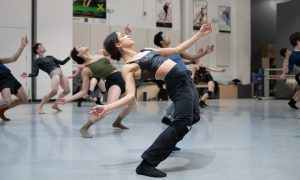When the National Endowment for the Arts (NEA) announced substantial funding withdrawals earlier this year, the impact was immediate and has continued to ripple through the arts community. The NEA has been a long-time critical resource for artists around the country, providing financial support as well as optimism for future funding. Now, months after the dance industry was affected, Dance Informa caught up with Jon Lehrer, Artistic Director of Jon Lehrer Dance Company, to hear the distress of this change in financial support.
The NEA grant that the Jon Lehrer Dance Company received was specifically for a one-week tour to Fairfield, Iowa, to offer free classes, workshops and a performance to the community. “This program, performance and outreach was designed to bring professional, community focused dance to people who do not have the opportunity to experience and interact with it, primarily due to socio-economic and geographical barriers,” Lehrer explains.
While this was a devastating loss for the attendees, it was a hard hit for the company staff, which consists of Lehrer and Associate Director, Cristiana Cavallo. “The amount of work we put in was not even close to the grant amount, which we know is unfortunately common, but because of the great history of how giving the NEA has, we knew that being awarded this grant could lead to potential future grants as well,” Cavallo says. “If we put the work in now for a modest grant, we could set ourselves up for more awards in the future.”
Immediately, when the NEA withdrawals were announced in May 2025, Lehrer says, “We had to cancel six weeks of rehearsal time.” Not only did this add more stress by eliminating over half of their planned rehearsals prior to their tour, but it also “greatly affected the dancers’ contracts, which means less money for them and less time to prepare for very grueling tours.” While it seems obvious that the funding cuts would hurt dancers greatly, it expands to more than that. “The effects of losing a grant like this has a tremendous domino effect on every aspect of the company,” Lehrer explains. With funds lacking in certain areas, it put more “pressure on our Board to raise money beyond what we had expected or budgeted for and burdens our already over-stretched staff with the task of finding and obtaining more grants.”
When asked what Lehrer wishes the public knew about the NEA grants, he replies with, “This was our first-ever NEA grant. However, we have been applying for and working toward getting one for 15 years. That is how long it often takes to get on their radar. NEA grant applications are notorious for being highly competitive and highly demanding. You must show a long and successful track record of artistic and financial excellence and stability and must have great experience and staff support in the application process. This takes a very long time. We, like so many, put years and years of effort into getting an award from the NEA, so you can imagine the joy and celebration we had when we were finally recognized for our long-term work and awarded a grant.”
As dance companies across the country continue to navigate this new season with lack of funding, it is clear that it is affecting more than just the dancers and their income. The accessibility of dance reaching other communities, future opportunities and government supported arts is threatened.
By Abby DeReamer of Dance Informa.

















